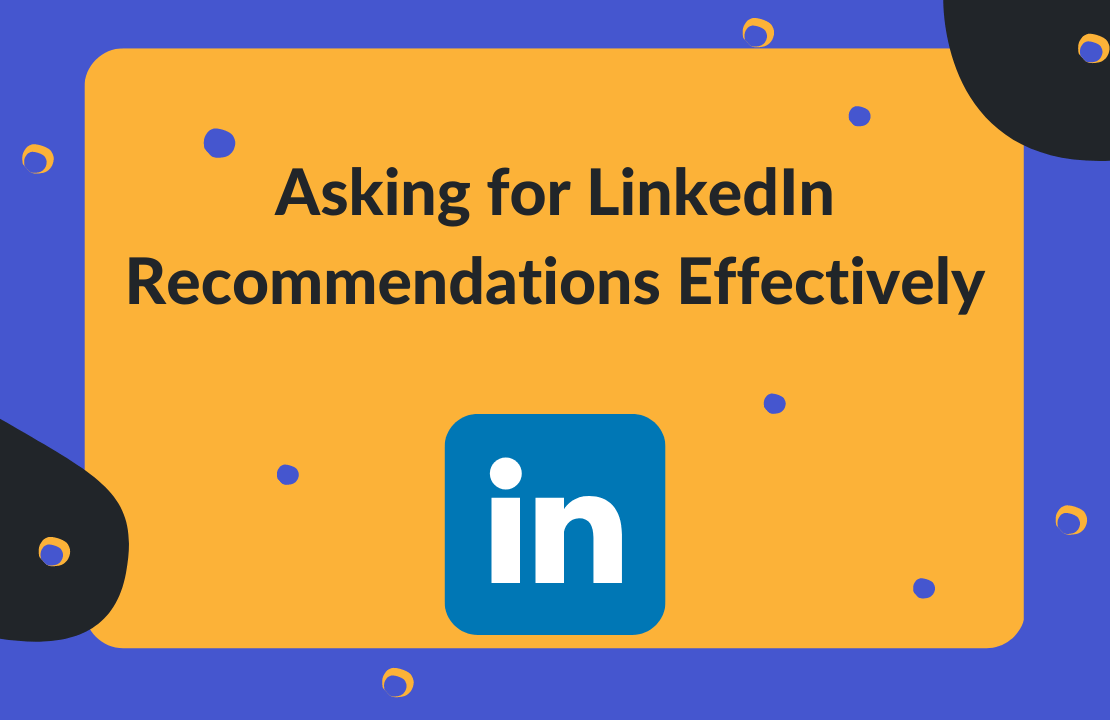In today’s digital age, your LinkedIn profile is like your online business card. One of the best ways to showcase your professional credibility is through recommendations. These testimonials from colleagues, clients, or mentors can enhance your profile, making it stand out to potential employers or clients. So, how do you go about requesting these valuable endorsements? Let’s dive in!
Why Recommendations Matter for Your Profile

Recommendations are more than just a nice addition to your LinkedIn profile; they are powerful tools that can significantly influence your career trajectory. Here’s why they matter:
- Builds Trust: Recommendations provide social proof. When someone vouches for your skills and work ethic, it instills confidence in potential employers or collaborators. It’s like having a personal reference right there on your profile!
- Highlights Your Skills: Different people can highlight various aspects of your professional persona. A former manager might speak to your leadership skills, while a peer might focus on your teamwork abilities. This diversity gives a well-rounded view of your strengths.
- Enhances Visibility: LinkedIn’s algorithm tends to favor profiles with more recommendations, which means you’re more likely to appear in searches. More visibility could lead to job offers, networking opportunities, or partnerships.
- Personal Branding: Each recommendation allows you to shape your narrative. You can guide your recommenders to focus on specific skills or achievements that align with your career goals, reinforcing your personal brand.
Moreover, recommendations can also serve as a great conversation starter. When you connect with someone, they might notice a mutual connection or a glowing recommendation, making your outreach more personal and relatable.
In essence, the power of a good recommendation cannot be overstated. It's a form of validation that enhances your professional story and makes you more appealing in a competitive job market. So, don’t hesitate to ask for recommendations—they could be the key to unlocking your next career opportunity!
Also Read This: How to Find and View Liked Posts on LinkedIn Easily
3. Preparing to Request Recommendations
Before diving into the world of LinkedIn recommendations, it’s essential to lay the groundwork. Think of this as preparing for a big exam; you wouldn’t walk into it unprepared, right? Similarly, a little preparation can make your recommendation requests more effective.
First off, reflect on your accomplishments. Take a moment to jot down a few key projects, skills, or achievements that you would like to highlight in your profile. This will not only help you articulate your request but also guide your connections on what to focus on when writing their recommendations. For instance, if you led a successful marketing campaign, mention that specifically!
Next, choose your timing wisely. Timing can significantly influence the likelihood of receiving a positive response. Reach out to your connections after a successful collaboration, project completion, or even after a great conversation. You’re more likely to get a glowing recommendation when the memory of your work is fresh in their minds.
Lastly, make it personal. When requesting a recommendation, don’t send a generic message. Tailor your request to each individual. A good template could look like this:
- Begin with a friendly greeting: A simple “Hi [Name]!” sets a pleasant tone.
- Express your appreciation: Mention something specific you value about your relationship or their support.
- Be clear about your request: Politely ask for the recommendation and specify what aspects of your work you’d like them to cover.
By preparing thoughtfully, you’ll set the stage for a more meaningful exchange. So, take a moment to gather your thoughts and think about the approach that feels right for you!
Also Read This: Do You Really Need a LinkedIn Profile? Exploring Its Role in Job Searching
4. How to Identify the Right Connections for Recommendations
Now that you’re ready to ask for recommendations, the next step is figuring out who to ask. Not everyone in your network will be the right fit, so let’s break down how to identify the best connections for this important task.
Start with your direct collaborators. These individuals have first-hand experience working with you and can speak to your skills and contributions in a detailed manner. Think about colleagues from recent projects, supervisors, or even clients who have seen your work up close. They’re often the most credible sources for recommendations.
Next, consider your mentors and industry leaders. If you’ve had the privilege of working with someone who has a strong reputation in your field, don’t hesitate to reach out! Their endorsement can carry weight and can enhance your profile significantly. For example, if you interned under a well-known marketing director, their recommendation could open doors for you.
Additionally, think about the breadth of your network. It’s not just about asking for recommendations from those at your current job. Don’t forget previous employers, professors, or even networking contacts from industry events. Each of these connections can provide a unique perspective on your skills and work ethic.
Finally, evaluate the relevance of your connections.
- Ask yourself: Have you worked closely with this person?
- Do they understand your career goals and achievements?
- Can they provide specific examples of your work?
By focusing on these criteria, you’ll be able to pinpoint the right connections who can provide impactful recommendations tailored to your career aspirations. Remember, quality over quantity is key here!
Also Read This: Are LinkedIn Messages Truly Private? How the Platform Protects Conversations
5. Crafting an Effective Recommendation Request
When it comes to requesting recommendations on LinkedIn, the key lies in crafting a thoughtful and personalized message. Here are some tips to help you create an effective recommendation request:
- Be Specific: Clearly state what you would like the recommendation to highlight. Whether it's a project you worked on together or specific skills you demonstrated, elaborating on these details can guide your recommender.
- Personalize Your Message: Instead of sending a generic request, take the time to personalize each message. Mention shared experiences, projects, or memories that you cherish. For example, you might say, “I really enjoyed our time collaborating on the ABC project; your insights helped me grow tremendously.”
- Keep It Short and Sweet: While it’s important to provide context, don’t overwhelm your recommender with a lengthy message. Aim for a few concise paragraphs that get right to the point.
- Be Gracious: Always express gratitude in your request. A simple, “I’d appreciate it if you could take a moment to write a recommendation for me,” can go a long way in showing respect for their time.
- Provide Examples: If appropriate, provide examples of what you’d like mentioned in the recommendation. This could include skills, accomplishments, or attributes that you believe stand out in your work.
Here’s a sample recommendation request:
Hi [Name],
I hope you’re doing well! I’m reaching out to see if you’d be willing to write a recommendation for me on LinkedIn. I truly valued our collaboration on the XYZ project, where we achieved [specific outcome]. If you could highlight my [specific skill or quality] in your recommendation, it would be greatly appreciated. Thank you so much for considering this!
Best, [Your Name]
Remember, the more thoughtful your request, the better the chances of receiving a glowing recommendation that can enhance your LinkedIn profile!
Also Read This: How to Add a Link in a LinkedIn Post for Better Engagement
6. Best Practices for Following Up on Your Requests
After you’ve sent out your recommendation requests, it’s important to follow up appropriately to ensure you receive the recommendations in a timely manner. Here are some best practices for following up:
- Wait a While: Give your contacts a reasonable amount of time to respond—generally about one to two weeks. People have busy schedules, and it's only fair to give them time to write a thoughtful recommendation.
- Send a Gentle Reminder: If you haven’t received a response after a week or two, consider sending a polite reminder. Keep it friendly and concise, such as, “Hi [Name], I hope you’re well! I wanted to follow up on my previous message regarding a recommendation. If you’re able to help, I would greatly appreciate it!”
- Offer Assistance: Sometimes, people might hesitate because they’re unsure about what to write. You could offer to provide a brief summary of your accomplishments or your professional journey to make it easier for them.
- Show Appreciation: Regardless of whether or not they agree to write the recommendation, always thank your contacts for considering your request. A little appreciation can go a long way in maintaining good relationships.
- Keep Track: If you send multiple requests, consider keeping a list of who you’ve asked and their response. This way, you can manage your follow-ups without feeling awkward about sending too many reminders.
In conclusion, following up on your requests with tact and grace can greatly enhance your chances of receiving valuable recommendations that highlight your strengths and accomplishments. Remember, a strong LinkedIn profile is a powerful tool in your professional toolkit!
Also Read This: How to Change the Email ID in LinkedIn: A Step-by-Step Process
7. How to Showcase Recommendations on Your Profile
Once you’ve gathered those glowing recommendations on LinkedIn, it’s time to make them shine on your profile! Showcasing your recommendations effectively can significantly enhance your personal brand and help you stand out to potential employers or clients. Here are some tips on how to do just that:
- Position them strategically: Your recommendations are best showcased in the Recommendations section of your profile. Be sure to keep this section visible and consider placing it near the top of your profile so visitors see it immediately.
- Highlight key excerpts: If a recommendation contains a particularly striking phrase or achievement, consider quoting that in your summary or experience section. You could say something like, "John's ability to drive project success was highlighted as 'transformative' by my last manager." This draws attention and adds credibility.
- Use visuals: For those particularly standout recommendations, consider creating a visual graphic to share on your LinkedIn feed. You can use tools like Canva to design an eye-catching post that features a quote from the recommendation along with a professional image.
- Share the love: Consider posting about your recommendations. You can create a post thanking the individuals who took the time to write them. This not only highlights your recommendations but also encourages others to engage with your profile.
- Link them to specific skills: When you ask for recommendations, try to guide your recommenders to focus on specific skills you want to highlight. For example, if you’re aiming for a role in project management, ask them to speak specifically about your project management skills, and then ensure that those recommendations are front and center in your profile.
By effectively showcasing your recommendations, you’ll not only enhance your profile but also build trust with potential connections. Remember, recommendations serve as testimonials that can influence hiring decisions much like reviews do for a product. So, don’t shy away from letting your recommendations do some selling for you!
8. Conclusion and Next Steps for LinkedIn Success
As you wrap up this journey into the world of LinkedIn recommendations, remember that they are more than just a few words on your profile. They are vital pieces of your professional narrative, showcasing your skills, work ethic, and the impact you’ve made in your field. So, what's next?
- Solicit more recommendations: Keep building your network by continuously asking for recommendations. Make it a habit to request them after completing successful projects or when you've received positive feedback.
- Update your profile regularly: As your career progresses, so should your LinkedIn profile. Regular updates with new skills, achievements, and further recommendations keep your profile fresh and engaging.
- Engage with your network: Don’t just sit back and wait for others to recommend you. Be proactive—engage with your connections, endorse their skills, and write recommendations for them. This reciprocity can often lead to recommendations in return.
- Utilize LinkedIn features: Explore LinkedIn’s various features like posts, articles, and groups to further establish yourself in your industry. Sharing your insights can boost your visibility and attract more recommendations.
- Stay authentic: Always seek recommendations from individuals who genuinely understand your work and can speak authentically about your contributions. Authenticity resonates with readers and adds more value to your recommendations.
In conclusion, embracing the power of LinkedIn recommendations is a step toward building a robust professional profile. Whether you’re job hunting, networking, or just looking to enhance your presence, these testimonials can be your best allies. Now go ahead, put these strategies into action, and watch your LinkedIn profile transform into a powerful tool for your career advancement!
 admin
admin








